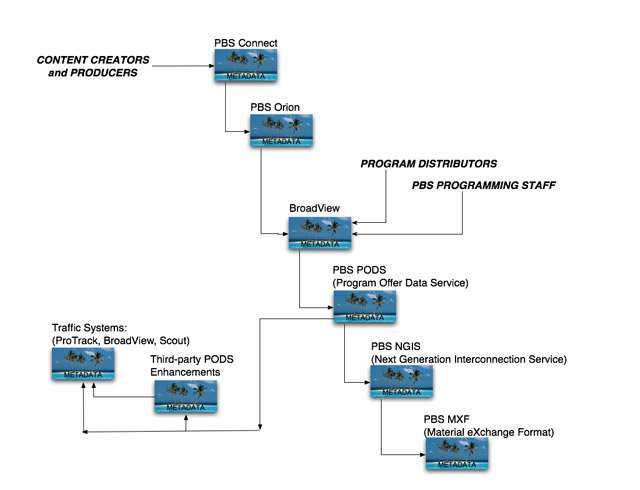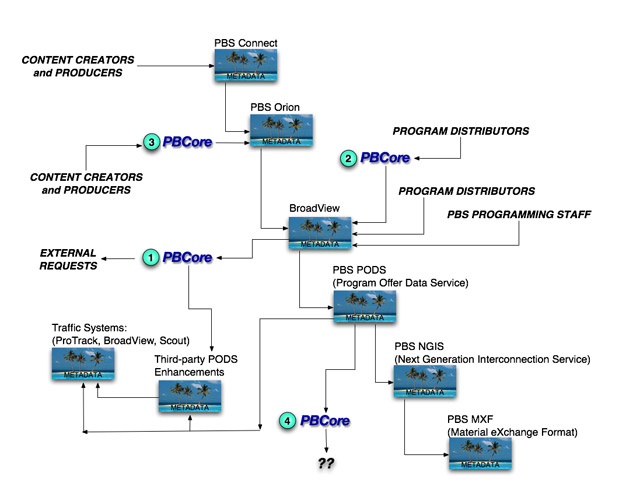| Applying
PBCore: Case Examples
of the Elements in Use |
PBS (Public Broadcasting Service)
& Metadata Supply Chains
 Context Context
 PBCore Integration PBCore Integration
 Contacts Contacts
 Other Case Examples Other Case Examples
CONTEXT:
In September 2001, PBS embarked on the creation of a web-based portal to serve the needs of its producers and various programming constituents. PBS Orion emerged as a central system for data collection and data management designed to streamline the sharing of PBS programs. The entrance into Orion's services is known as PBS Connect. PBS Connect is the online gateway through which public television professionals may access information, share resources and collaborate with colleagues throughout the public television community.
PBS Orion offers shared functionality for three key user groups:
- Program Distributors
- Program Producers
- PBS Programming Staff
All three groups generate volumes of information that PBS Stations need in order to meet their programming and broadcasting missions. Providing these groups with a way to share that information electronically via a Web-based interface is intended to improve the quality of program metadata, efficiencies in data entry, and the timeliness of data sharing. While not all PBS and Member Station staff directly access data through Orion, they benefit from its functionality and the enhanced control over the metadata supply chain.
PROGRAM DISTRIBUTORS...
Agencies and Organizations who acquire, sell, and distribute programming.
Program Distributors use Orion to support their distribution of program data to PBS Member Stations. Staff from program distributors, such as American Public Television (APT) and the National Educational Telecommunications Association (NETA), log directly into the PBS Orion portal and either key information into the central data system managed by BroadView.
PROGRAM PRODUCERS...
Stations and Independent Producers and Program Creators who generate original program content.
Program Producers use the PBS Connect portal into Orion to supply program metadata that is required by PBS during the acceptance procedures for the Program Acceptance Agreement (Red Book). This agreement initiates the lifecycle of a submitted program to PBS as it passes through many checkpoints and processes before being accepted and vetted for PBS distribution. Program Producers supply such information as titles, formats, funders, credits and clearances.
PBS PROGRAMMING STAFF...
Internal PBS information managers who police the central database.
Those who manage all the data for PBS program offers and distribution can use Orion to update the central program management and scheduling information managed by BroadView.
The software at the center of the service functionality is BroadView. This fully integrated program management, traffic and scheduling software combines program acquisitions, scheduling, traffic, ad management, reporting, automation management and more, with the goal of entering or supplying data once and disbursing it throughout other information systems or data delivery mechanisms, implemented now or envisioned in the future.
Out of BroadView, PBS creates its Program Offer Data Service or PODS. PODS provides a daily distribution of database files, drawn from BroadView and delivered to PBS stations (or through third party data transformation services, such as Scout ProgramsPlus! and Myers ProLink exports for stations using the Myers ProTrack scheduling and traffic system). These reports contain most of the information PBS stations need to anticipate future program offerings and confirmed PBS distribution schedules. According to PBS, the latest version of PODS...
...provides substantially more schedule information than previous versions of PODS. What is important to note about this schedule information is that PBS now has the tools to provide more information, earlier. In addition, the scheduling style now allows PBS to provide rough and approximate schedules well in advance of where schedule information may have been presented in the past. Schedule information should be thought of as moving from rough, approximate schedules (the furthest schedules into the future) to accurate, fully complete schedules (closest to day of air). The shift from approximate schedules to exact schedules can be subtle and occur over time, but generally makes the transition approximately two to three months out from day of air.
Below is an illustration approximating the metadata supply chain for PBS program data as it exists today.
- Content Creators and Producers submit program data to the PBS Orion System through the PBS Connect portal.
- Program Distributors have direct access into Orion and the BroadView data system to submit their program information.
- PBS Programming Staff also have direct access to BroadView.
- An output of BroadView is the PODS Program Offer Data Service
- PODS records are distributed back to station traffic systems, either directly or through third-party data wranglers who may vet or enhance PODS data before passing it to stations.
- Future NGIS scenarios may wrap video and audio essence, their associated descriptions, recording or encoding information, and underlying format attributes as data layers within a Material eXchange Format (MXF).
PBS METADATA SUPPLY CHAINS: CURRENT SCENARIOS

PBCORE INTEGRATION:
PBS is deeply involved in the maturation of the Orion/BroadView metadata elements, their definitions, semantics, syntax and structure, as well as the vocabulary terms and authorities used to ensure consistent and accurate metadata descriptions. Data managed in the PBS systems are exchanged in a number of ways, as demonstrated in the illustration above.
Can PBS determine what value PBCore offers as yet another metadata record format that follows its own metadata dictionary and schema and exists external to the current PBS Connect portal and the Orion system with BroadView? Four hypothetical scenarios have been reflected upon. None represent a strategic plan of action or suggest a commitment of resources and support to realize these scenarios. But given the use of PBCore at station levels and by Content Producers, it is fruitful to examine where value may exist when and where PBCore can interact with the PBS Metadata Supply Chain.
Hypothetical Scenario #1...
- Build an export function out of BroadView which maps selected metadata from the PBS system into a PBCore compliant record or records. Submit that data to third-party traffic and scheduling vendors, such as Myers, for import into their systems with a pass-along to stations for use in non-traffic or non-scheduling data exchanges within their operations. Alternatively, if requests are made for program data that are not related to traffic or scheduling needs, BroadView can export and distribute program descriptions as PBCore compliant records, delivering them to the original requester to satisfy whatever information needs they have. The request could hypothetically be as simple as "Can you give me a PBCore compliant record for this specific program or series so I can push the descriptions to my Education Connections website for K-12 educators?"
Hypothetical Scenario #2...
- Enhance the ability of Program Distributors, such as NETA, to upload data into BroadView from pre-existing metadata records that were created and stored as PBCore compliant files. PBCore would perform as the base structure in an electronic exchange format, expediting data submissions and exchange with the PBS systems.
Hypothetical Scenario #3...
- • Enhance the ability of Content Creators and Producers, such as stations and production agencies, to upload data to PBS Orion from pre-existing metadata records that were created and stored as PBCore compliant files. PBCore would be mapped into the Orion data structures, expediting data and program submissions to PBS from Producers wishing to avoid manually re-keying program descriptions into the PBS Connect Portal.
Hypothetical Scenario #4...
- Map the PODS data structure to PBCore's metadata schema, recognizing that PODS is primarily about schedule information, while PBCore is extensively about capturing the intellectual content and format renditions of media assets. The value of a PODS/PBCore crosswalk may be limited, considering that the selected data housed in the central database, BroadView, can be mapped to PBCore and exported in file formats that PBS constituents can better utilize (see Hypothetical Scenario #1).
These hypothetical scenarios that exploit PBCore can be captured in the following revised illustration of PBS Metadata Supply Chains .
PBS METADATA SUPPLY CHAINS: HYPOTHETICAL SCENARIOS WITH PBCORE

These hypothetical scenarios that exchange data between the PBS systems and PBCore compliant metadata files are worthy of further discussion. Opinions and comments can surely be posted to the PBCore User Group Listserv where the PBCore Community can share their thoughts and concerns.
As an aside, in highlighting the synergies between PBS and the PBCore Project, standard PODS vocabulary terms play a key role in several PBCore picklists. For example...
- PBCore subject terms can be drawn from the PBS Topic Keywords developed over the last several decades under the watchful eye of Glenn Clatworthy. The topical keywords are published for PBCore users to harvest at https://secure.connect.pbs.org/pbsdocuments/pbs/PBCore/.
- PBCore genre terms are matched to the Tribune Media Services/TiVO descriptors also used by PBS for printed and electronic program guides.
- PBCore audience ratings are harmonized with the terms and syntax used by PBS PODS to flag programs with the appropriate FCC audience ratings.
CONTACTS:
Michael Hunt |
mhunt |
@ |
pbs.org |
Glenn Clatworthy |
gclatworthy |
@ |
pbs.org |
Thomas Edwards |
tedwards |
@ |
pbs.org |
|
|
PBS Topic Keywords Authority |
|
|
|
|



